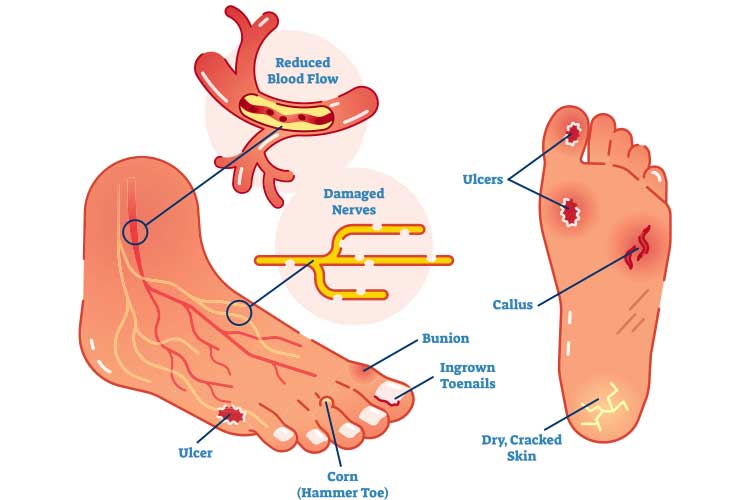How Diabetes Affects Your Feet
While most people think ‘blood sugar’ when they first hear the term diabetes, it can have a devastating impact on your feet because of the way that your sensation (feeling) and your circulation (blood flow) are affected. The truth is that diabetes is the leading cause of lower limb amputation – aside from traumatic accidents. This means that it’s crucial to look after your feet if you have diabetes, especially as your symptoms progressively worsen over time.
Today, the Marlborough Podiatry team are sharing how your feet are affected, the symptoms you need to look out for, and what you should be doing at home to help keep your lower limbs safe.

Diabetes damages your nerves and vessels
When you have diabetes, your ability to absorb sugar (glucose) from your bloodstream to deliver it to the tissue cells around your body that need it for healthy function, is impaired. This means that high levels of glucose remain in your bloodstream, producing toxins that affect all body organs and systems, including your circulatory system and the peripheral nerves in your feet and legs. Simply put, your ability to fight infection, supply enough oxygen and nutrients to your cells, efficiently heal wounds and your general ability of your feet to feel what is happening around them, all worsen.
Peripheral neuropathy
Our nerves are responsible for our ability to feel, detecting even the lightest sensations, like a feather being moved across our toes. When our nerves are damaged, our ability to feel can fade, become mixed up, and may eventually be lost altogether. This is called neuropathy.
Neuropathy can feel like numbness, burning, tingling, or pins and needles. The most dangerous sensation change is the complete absence of feeling, as opposed to a numb feeling where you still detect pressure and other changes. This means that you can sustain a cut, not know it’s there, and not take the right measures to disinfect it, dress it and let it heal. This makes you vulnerable to infection and if left unmanaged, amputation.
While diabetes is a major cause of neuropathy, it can also be caused by other factors like inflammatory diseases or infections, alcohol, autoimmune disorders, kidney failure, poor nutrition, hereditary disorders and more.
Diminished circulation
When your circulation is impaired, your tissues aren’t able to receive the regular, healthy amount of blood (with the oxygen, nutrients and immune cells) they need to thrive and effectively carry out essential cellular processes. You may notice changes in the feet like a pale, dry skin appearance, brittle toenails, perpetually cold feet, and a lack of hair growth on the toes.
A poorer blood supply means that when you sustain a wound, it will take longer for the body to heal, leaving it open and vulnerable to picking up an infection for longer, especially when you consider how the feet are closer to more dirt and bacteria. If an infection takes hold, your impaired blood flow also makes it more difficult for your body to fight it, creating a myriad of potential problems. This is why it’s essential to take good care of your feet if you have diabetes.
Looking after your feet at home
Knowing what to look out for, and caring for your feet at home on a daily basis can help prevent many diabetes-related complications through early detection. We recommend that you:
- Check your feet every day for any new marks, spots, cuts, swelling or redness
- Hold your feet up to a mirror if you can’t see the bottom of your feet to check for anything out of the ordinary
- Alert your GP or podiatrist if you notice any unusual changes
- Wash feet your feet every day, carefully drying them thoroughly, especially in the spaces between the toes
- Moisturise your feet (ideally after showering and before bed) to help promote your sensation (hard, dead skin reduces sensation)
- Wear well-fitting shoes that have a good width and depth, both inside and outside of the house, to minimise your risk of damage
- Avoid walking around with bare feet
- Use socks that wick moisture away from your feet
- Take all of your medications, as prescribed by your GP
- Don’t bring your feet in direct contact with heaters, hot water bottles, scalding hot showers/baths and electric blankets
Get a foot check every year
It is recommended that you have an annual diabetic foot check with your podiatrists every year. Here at Marlborough Podiatry, we check the status of your sensation and circulation, discuss your symptoms and what they mean when it comes to protecting your feet, and give you advice on how to best manage your symptoms and maintain your foot health.
We also provide treatments including corns and callus removal, cracked heel treatment, trimming and thinning thickened or elongated toenails, checking if your biomechanical foot function is putting you at risk of injury, and more. We’re proud to be the only clinic in the area that has a Radial Pressure Wave (RPW) machine which helps to promote your vascular flow.
Book your appointment online by clicking here or call us on (03) 972 2927
